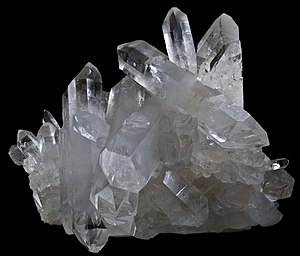Nature/Matter
Introduction
[edit | edit source]The world consists of matter (substance) and energy (radiation). These two can have a variety of ordered and random forms (structures). They can also be converted into one another under certain conditions.
An unanswered question is whether the structure ( = information) is only a property of matter and energy, or whether it is an independent basic substance. The currently prevailing doctrine does not see any independent substance in information.
What is matter?
[edit | edit source]Matter is a general term for everything material that surrounds us and of which we ourselves are made.
Physical
[edit | edit source]In the physical sense, matter is everything that has a non-zero rest mass. The defining properties of matter are its mass, volume, structure and internal thermal energy. Matter in a broader physical sense includes matter in the narrower sense as well as antimatter.
Properties of Matter
[edit | edit source]
Matter has some important properties:
States of Matter
[edit | edit source]Gif files of the different states of matter



There are several manifestations (states of matter) of matter, for example:
- solid
- fluid
- gaseous
- plasma
- Bose-Einstein condensate
- fermion condensate
When matter transitions from one state of aggregation to another, the inner order of matter changes greatly. The entropy changes significantly even if the temperature remains the same. Entropy is a measure of the random structure of matter particles.
No Matter
[edit | edit source]- Electromagnetic radiation, just like all other (rest massless) bosons, is not conceived as matter in a narrow sense.
- Mathematical concepts like points, lines, and planes are immaterial.
- vacuum contains little or no matter.
Creation of matter
[edit | edit source]According to the current cosmological standard model, large amounts of energy were released during the Big Bang.
These massive amounts of energy led to the formation of large amounts of densely packed elementary particles. In the so-called hadron era between 10-32 and 10-4 seconds after the Big Bang, the first stable protons and neutrons came into existence.
In the so-called Lepton era up to the 1st second after the big bang, the first stable electrons were created. Up until this time, matter and antimatter annihilated each other. In the end, the matter was left behind. Why only matter remained and not antimatter is unexplained.
In the following radiation era, hydrogen , deuterium and tritium were formed.
Today's matter era began about a million years after the Big Bang. The hydrogen clouds formed galaxies and stars and in those the hydrogen fused into helium and onto carbon and iron, the most common chemical elements in our universe.
It is assumed that the heavier, rarer elements such as gold, lead, and uranium were created by the collision of neutron stars, but especially in supernovae.
Extension of the term: Matter
[edit | edit source]With the development of his Special Theory of Relativity Albert Einstein provided the well-known formula
This means that electromagnetic radiation (light, heat rays, etc.) can also be assigned a 'dynamic' mass. Hence the condition that matter must have mass is satisfied by the condition that matter must have mass at rest.
Conversely, massive matter particles also have wave properties (see the theory of matter waves by Louis Victor de Broglie). This means that the particles can no longer be precisely located. Instead, however, a statement can be made about the probability of their location.
Matter is built up from atoms. And atoms are made up of fermions. In the group of fermions the three well-known particles
- the electron,
- the proton and
- the neutron,
are found.
Protons and neutrons are made out of quarks.
Philosophically
[edit | edit source]
The concept of matter is a central concept of philosophy. What matters actually is has been the subject of controversy since the beginning of philosophy. Today, this discussion has died down completely, since physics and chemistry have very successfully adopted the term and partially clarified it. On the other hand, the philosophical discussion about the Mind-Matter Contrast is still in heat today.
Antiquity
[edit | edit source]According to the Greek Pre-Socraticsn, the building blocks of reality were the 4 'elements':
- Fire,
- Water,
- Air and
- Earth.
This four elements theory is outdated today and only of historical interest.
Middle Ages
[edit | edit source]In the Middle Ages, the scholastic doctrine of matter is based on the basic concepts of Aristotle and expands on them. The starting point is the problem of becoming. To explain this requires a permanent and changing part. The remaining part is matter (also called cloth). The changing part is the immaterial form (forma).
Modern Times
[edit | edit source]According to Kant, matter primarily has 2 properties: Expansion and mass. It is matter
- about an understandable term implying space (extent), and
- a comprehensible view in which the mass has been added to the space.

Matter as a philosophical category is not defined by the Marxist-Leninists by enumerating physical properties, but by formulating the opposite to consciousness. Matter in this philosophical sense includes everything that exists independently of consciousness.
Materialism is the philosophical teaching, according to which the entire reality can be structured materially and accordingly understood purely materially. It was especially popular in the 19th century.
Most scientists today believe in an informed materialism, i.e. the world consists of matter (and energy). The structure of matter contains all of its spiritual possibilities. It is not yet clear if there is an independent basic substance of information.
Norbert Wiener, the founder of cybernetics , said: Information is information, neither matter nor energy. No materialism that does not take this into account can survive today.
